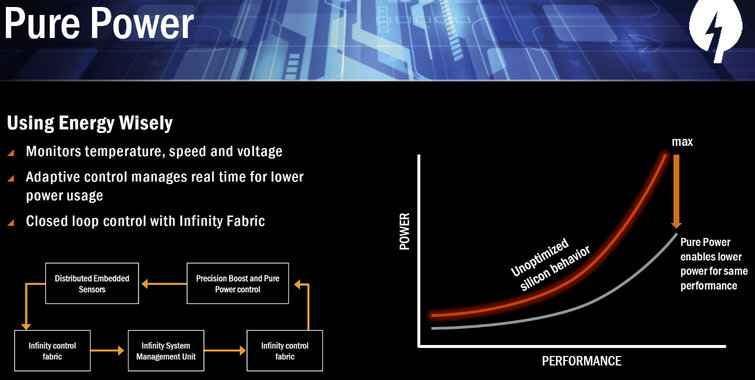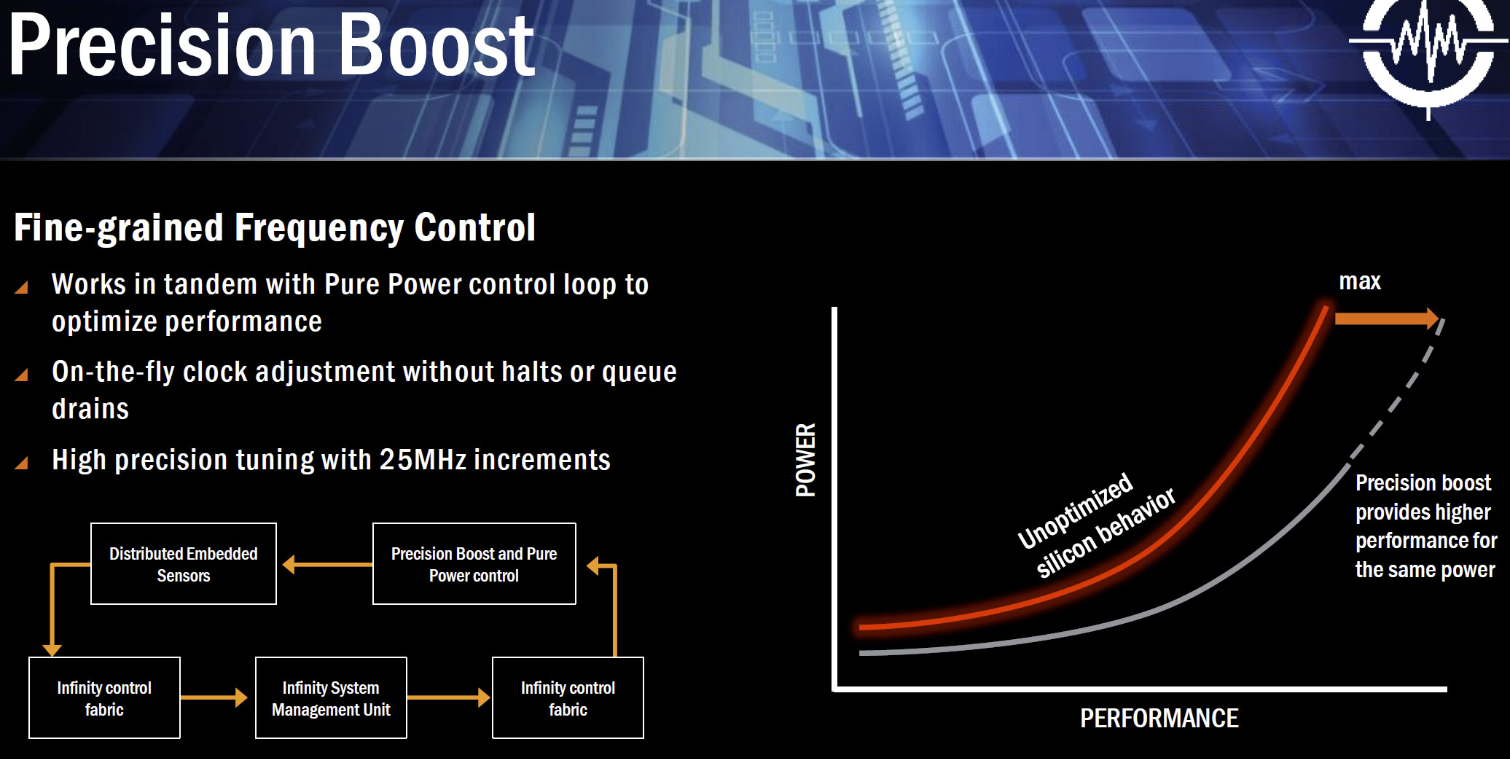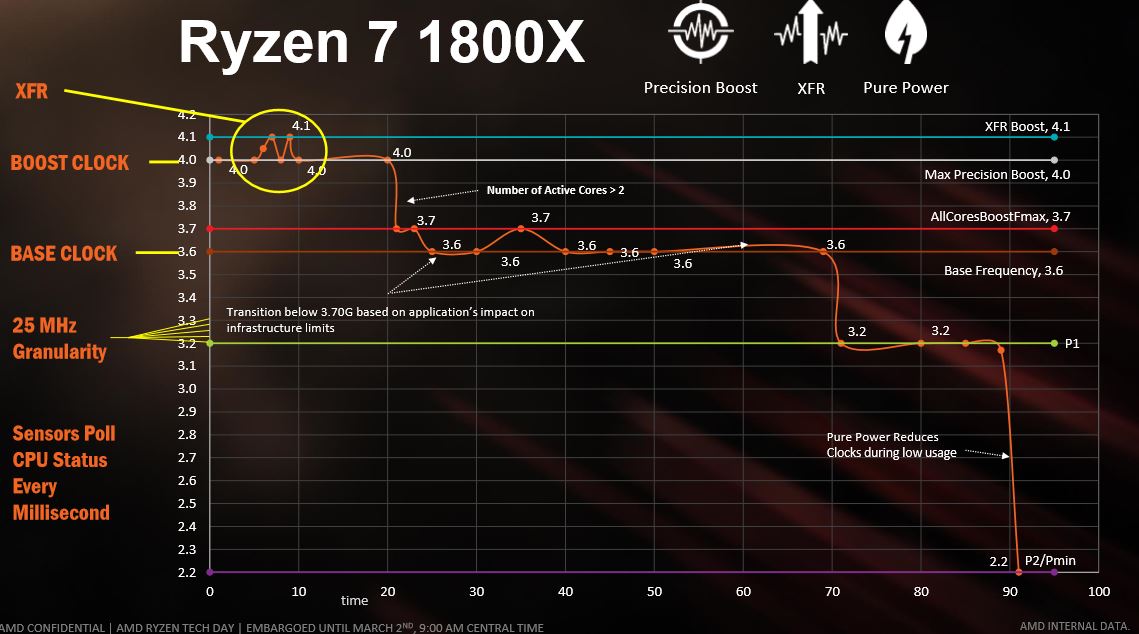AMD's SenseMI suite consists of five key technologies that allow AMD's Ryzen 7 processors to adjust performance and power consumption parameters in real time.
Pure Power
AMD's Zen architecture uses an array of 1000 sensitive sensors to accurately measure up to 1mAh, 1mV and 1C. AMD's Pure Power function monitors temperature and voltage, allowing real-time parameter adjustments based on decisions made by learning algorithms.

These sensors feed the Infinity System Management Unit with telemetry data at 1000 ms intervals via the Infinity Factory Loop. The Management Engine then analyzes the data and issues commands over the fabric to adjust voltage and clock speed for optimal performance. AMD also noted that this should help manage speculative cache features and AI-based branch prediction.
Each piece of silicon is unique in detail, and according to AMD, its algorithms are designed to allow the processor to optimize itself in the best possible way based on its unique features. At this point, however, it should be noted that most current processors use a similar technique to dynamically adjust their power consumption.
Precision Boost

Precision Boost optimally adjusts the power consumption performance curve to the respective operating conditions— similar to Intel's Turbo Boost – using information generated by the Pure Power feature. Precision Boost algorithms adjust clock and voltage in real time in a granular way – but where Intel adjusts the clock clock in 100 MHz increments, AMD now works with 25 MHz steps.
Precision Boost only brings a single core to four gigahertz, while Intel's Turbo Boost can increase the clock of multiple cores – albeit with different maximum clock frequencies depending on the number of active cores. For example, the core i7-7700K creates a maximum of 4.4 GHz on four cores and can operate a single core with 4.5 GHz. AMD's single-core Precision Boost produces a nice performance increase in "light" workloads, but leaves a little bit to be desired compared to Intel's sophisticated multi-core Turbo Boost.
XFR (eXtended Frequency Range)
AMD's XFR feature allows the processor to dynamically increase its clock speed over the factory and precision boost clocks when sufficient thermal reserves are available.

XFR increases the base and precision boost clock of the Ryzen 7 1800X by 100 MHz each if the built-in cooling solution is potent enough. We tested with the Noctua NH-U112S SE-AM4 air cooler and the Corsair H100i v2 water cooler: both coolers allowed the processor to raise the base clock of all cores to 3.7 GHz and clock a single core at 4.1 GHz.
However, we don't (yet) have AMD factory coolers in the lab, so we can't test whether it also removes enough waste heat to trigger the XFR algorithms.
AMD also claims that the feature scales with air, water and liquid nitrogen cooling, but has not commented on the maximum clock rates that can be achievable with nitrogen cooling. XFR can only lift a single core above the 4 GHz threshold defined by Precision Boost.
Interestingly, the Precision Boost and XFR features on our test motherboard (an Asus Crosshair VI Hero) are intertwined. When you turn on the Core Performance Boost setting, the 1800X activates both Precision Boost and XFR based on the workload conditions, but you cannot turn the two features on or off independently. The additional single-core boost from XFR is a nice entry, but can't keep up with the performance growth through overclocking of all cores.
Neural Net Prediction & Smart Prefetch
According to AMD, its Neural Net Prediction consists of a neural network that learns from the behavior of applications, so that CPU instructions are available before they are needed. Smart Prefetch, on the other hand, selects the best data path through the CPU and loads data into cache memory for faster execution before it is needed.
Both features appear to be marketing labels for AMD's Perceptron Branch Predictor, which saw the light of day with the Jaguar core. AMD has most likely optimized this jump prediction for the Zen microarchitecture, but ultimately it is a common technology.
Apart from the usual marketing buzzwords, the Zen microarchitecture still offers different innovations and benefits compared to previous AMD architectures.
- 1 - Das Ryzen-Debüt
- 2 - AMD SenseMI Suite & XFR
- 3 - Die AM4-Plattform
- 4 - Overclocking und Test-Setup
- 5 - Power States und Cache-Tests
- 6 - Benchmarks: Ashes of the Singularity & Battlefield 4
- 7 - Benchmarks: Hitman, Project CARS & Metro: Last Light
- 8 - Ergebnisse: Desktop und Office
- 9 - Ergebnisse: Workstation
- 10 - Ergebnisse: Wissenschaftlich-technische Berechnungen und HPC
- 11 - Ergebnisse: Leistungsaufnahme und Abwärme
- 12 - Fazit
































Kommentieren